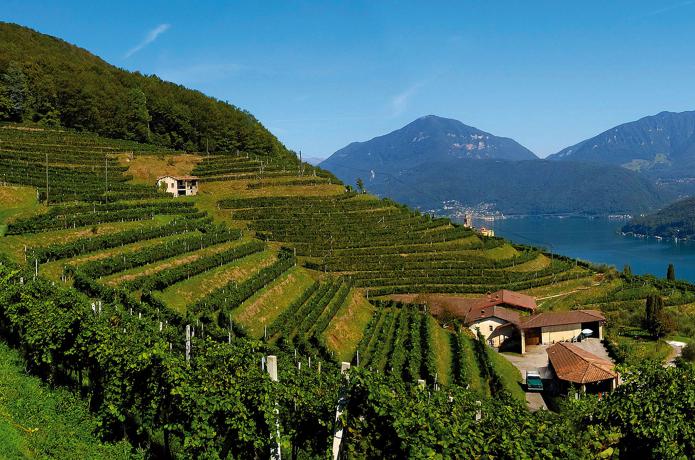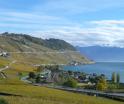A Toast to Switzerland’s Wine Country
- Tuesday 08 August 2017
Wine-lovers in search of a memorable red, white, or rosé will find Switzerland’s diverse grape-growing regions as surprising as they are scenic. From the shores of Lake Geneva to Schaffhausen near the German border, here’s a vineyard-hopping tour of the best of Swiss wine country.
Fondue and chocolate, sure. But Swiss merlot? If you’re not familiar with Switzerland’s impressive wine-growing heritage, don’t feel bad: the country only exports about two percent of its annual output, and most of that goes to neighboring Germany. In fact, many Swiss wines never leave their places of origin, which means the only way to sample them is to track them to their source.
Unlike its near neighbors, Switzerland’s wines are not controlled by a centralized appellation council, so grape expressions and cultivation methods run the gamut. Even the nomenclature of grape names vary from region to region, turning casual tastings into complex language lessons. What’s known as pinot noir in French-speaking Switzerland is called blauburgunder in the German-speaking areas. Because there are over 200 grape varietals grown in over 20 regions across the country, even experts are stymied by the linguistic confusion. But knowing where to start is the first step. The following breaks down Swiss wine by the nation’s four linguistic regions, along with inside recommendations for where to eat and what to taste once you get there. Salute, santé, viva, and prostli!
French Finesse
Nowhere in Switzerland is the wine better than in Romandy, the francophone region in the west. And there’s perhaps no better place to start your wine pilgrimage than the canton of Valais, home to more than three dozen 4,000-plus-meter peaks—including the iconic Matterhorn—and some of the country’s oldest and most distinctive vineyards. (Only the western half of the Valais is French-speaking, it must be noted; the canton is split by the so-called röstigraben, a linguistic equator that runs between Switzerland’s French- and German-speaking areas.)
While the Valais produces decent pinot noir, chardonnay, and cabernet, it’s the unique varietals you’ll want to seek out. Whites like amigne and dôle blanche and reds like humagne rouge and eyholzer roter are unusual and beloved by local vintners. Oenophiles have especially prized the dry minerality of whites such as Heida and sylvaner (or païen and Johannisberg in the dialect of upper Valais). They’re known for their stony, gunpowder characteristics that the Swiss French call pierre à fusil, which loosely translates to “rifle flint.” But by far the most popular of wines in the region and in all of Switzerland is chasselas (a.k.a. fendant). The Swiss may not agree about the nomenclature of the grapes, but the vast majority say that chasselas is the only wine that should be consumed with fondue, a rule seldom broken.
You can sample a stony chasselas and melony petite arvines at Cave Pierre-Antoine Crettenand in Saillon. The winery’s garden offers wraparound views of the Alps, while its old-world tasting room comes strewn with antique wine equipment. Nestled into the steep hills above the riverside town of Martigny is another must-stop, the Gérald Besse estate. Best known for its syrah, the winery also produces the nutty Païen Les Serpentines, which I can’t recommend highly enough. And don’t leave the Valais without visiting the fascinating Musée du Vin wine museum in the ancient city of Sierre.
Lavaux is another popular French-speaking wine area, and one of my personal favorites. Located to the east of Lausanne in the canton of Vaud, the lakeshore region is home to centuries-old terraces carved neatly into a rocky ridge peppered with slate-roofed chapels and lined with old stone walls that retain the sun’s heat, extending the grape growing season. The terraces, a UNESCO World Heritage Site, plunge down the mountain toward Lake Geneva like some sort of viticultural Machu Picchu. It’s breathtaking and unlike any wine destination I’ve ever seen.
The whites here are similar to those in the Valais, but their vines were planted by ninth-century monks who built the stone walls that now define the landscape. Unique varietals like doral and gamey are grown nowhere else. For a good introduction to the area, head to the village of Rivaz, where Lavaux Vinorama, a modernist wine museum and tasting room built discreetly into the hillside, offers a detailed overview of the region.
The best way to experience Lavaux is by visiting its villages and caveaux (wine cellars) on your own. There are dozens of chocolate-box hamlets to choose from, including Cully, Chardonne, Lutry, Grandvaux, and Epesses, each worth a sip in. (As with all vintners here, it’s best to call ahead to arrange tastings.) Brothers Jean-Francoise and Jacques Potterat at Vins Potterat are sixth-generation vintners with a caveau in the picturesque 10th-century village of Cully, where tastings take place in a 600-year-old wine cellar. They’re also one of the few producers making Plant Robert, an ancient red varietal that almost went extinct. And adjacent to the Cully train station, the Oenothèque at Les Frères Dubois makes for a good place to bag a few last-minute bottles of the winery’s Dubois Saint-Saphorin and Clos des Abbesses before catching your train.
Whatever you do, don’t leave Lavaux without one long, wine-drenched meal in one of its old-world auberges. My all-time favorite is Cully’s Auberge du Raisin, where formal waiters recall another era and the parquet ceiling is marinated in decades of fondue steam. Here, flanks of steak are charred in the dining room’s cozy fireplace. I paired mine with an extraordinary Calamin grand cru from Louis Bovard and a Viticole de Lutry chardonnay, both highlights of the meal. Afterward, I bunked down at Le Bourg 7, a small upscale guesthouse hidden among the winding cobbled streets of lakeside Lutry. The gracious reception clerk here doubles as a bartender and server, and while offering me tapas and refilling my glass of chasselas, she offered a wealth of advice, insider information, and downright gossip on the area’s wineries.
Teutonic Tastes
The German-speaking part of Switzerland—Deutschschweiz—comprises about 65 percent of the nation, with some of its most appealing wine country lying in the northeast. Here, at the tail end of the Jura plateau, is Schaffhausen, the most northerly of Swiss cantons. One of the few parts of Switzerland located on the north side of the Rhine, it’s surrounded on three sides by Germany, and its wines unsurprisingly have a distinct German style, favoring stainless-steel instead of barrel aging.
The rainfall, soil, and moderate climate in Schaffhausen are ideal for growing blauburgunder (pinot noir) and Müller-Thurgau (riesling-sylvaner), the region’s dominant grapes. From Schaffhausen’s eponymous cantonal capital, it’s a 25-minute drive to the wine village of Hallau, home to both a wine museum and Weinkellerei Rahm, a leading family-run winery. They produce all sorts of wines here—bio, sparkling, non-alcoholic—and offer comprehensive tours and tastings. Also worth a visit is Weinbau Markus Ruch. Ruch has only been making wines on his 2.5-hectare estate since 2007, but he turns out some excellent traditional expressions of Müller-Thurgau, cabernet franc, and weissburgunder.
The Deutschschweiz’s urban wine regions include Basel, St. Gallen, and suburban Aargau, all of which produce excellent grapes. Grapes are even grown right in the heart of Zurich, where I live, with perfectly groomed rows of vines lining the undulating hills along the River Letten and on the sunny slopes of Lake Zurich’s gold coast, ideal for weekend bike excursions. Most produce weissweine (white wines), but there are a few standout rots (reds) and even a notable rosé or two.
Zurich also has a wine-trail app and a wine-growing museum. Some neighborhoods, like Höngg, have their own wine route. And there’s no shortage of places in the city’s Old Town to put down a bottle of something local. Settle in for a rich, boozy dinner of champagne and cream soup followed by kalbsleberspiessli—veal liver, bacon, and sage butter—at the Öpfelchammer weinstube (wine tavern); founded in 1801, it has hosted centuries of famous diners, such as the 19th-century Swiss poet Gottfried Keller, who have carved their initials into the wall (and you’re invited to do so as well). Or head to Restaurant Volkshaus in Helvetiaplatz, which is favored by young designers, architects, and writers, most of whom come for generous pours of Swiss wine, just as I do.
True Romansh
The Romansh-speaking areas in Graubünden (Switzerland’s largest and easternmost canton) don’t, admittedly, grow much wine, being located high up in the mountains. But in the grape-filled valleys below, you can certainly hear Romansh being spoken. Maienfeld, for example: the birthplace of literary character Heidi is famed across Switzerland for its production of blauburgunder, much of which is consumed at the ski resorts of St. Moritz, Davos, and Arosa.
Graubünden’s 18 vintners, mostly in the small region of the Bündner Herrschaft, emphasize fruity-aromatic and elegant pinot noir alongside more delicate and citrusy pinots gris, which pair especially well with local dishes like salsiz and bündnerfleisch (air-dried sausage and meat), birnbrot (a moist pear-bread made with dried fruit and nuts) and sharp and creamy Alpine cheeses. The Weingut Schloss Salenegg is the oldest continuously operating winery in Europe, built by the abbot of Pfäfers Monastery who laid the foundation for the present castle and vineyard in 950 A.D. Martin Donatsch from the Donatsch estate in Malans has been chosen as Pinot Noir World Champion several times and is famous for his completer wine, a full-bodied acidic ancient grape that had become feral and notoriously difficult to work with. Gantenbein Wine in Fläsch is also well regarded in the international wine community, producing pinot noir, chardonnay, riesling, and marc—a velvety oak-barrel aged spirit made with grape, pomace, stems, and lees.
But the region is also rich with small, creative producers who work with cultivated areas of less than five hectares. For travelers who wish to combine hiking and drinking, there’s the Bündner Rheintal Wine Hiking/Cycling Trail, which connects the Bündner Herrschaft with the cantonal capital of Chur (pronounced with a guttural Hhuur). Farther up the valley, Reichenau Castle often hosts wine tasting and culinary events, thanks to its owner Gian-Battista von Tscharner, whose family produces wine in Chur, Reichenau, and other nearby villages.
In Vino Veritas
The mild climate of Switzerland’s Italian-speaking canton Ticino, on the sunny southern side of the Alps, is ideal for vino. Most of the local grapes are merlot, from which a range of fruity whites and robust reds are made—some considered to be the best in the country.
Three-quarters of all Ticino’s merlot grapes are grown in the hilly southern region of Mendrisiotto, which is almost entirely surrounded by Italy. So that’s a good place to start. Numerous autumn festivals celebrate the vendemmia (grape harvest) here, including the Sagra dell’uva, which showcases local dishes, wine, and music. But in any season you can reward yourself with a visit to Valsangiacomo Vini, the canton’s oldest vineyard. What started in 1831 as a small wine dealer is today one of the trailblazing pioneers of quality Ticino wines. The family business is run by sixth-generation owner Uberto Valsangiacomo, who produces outstanding red and white merlot grapes. I love this wine. Another celebrated vintner is Brivio, which stores its fabulous dry white merlots in ancient cellars dug into the base of Monte Generoso.
Ticino is more rugged and inaccessible than other parts of Switzerland, but it’s worth seeking out old stone rusticos where family-made wine in big jugs adorn the checkered-cloth tables of farm restaurants. A hiking excursion last fall brought me to La Faura in the tiny Alpine village of Cavagnago, in Ticino’s far north. A bowl of fragrant, pesto-laced minestrone, a thick slab of lasagna, and a few robust glasses of merlot revived me after a day’s hike, as did the staff’s warm, Italian-style hospitality. For a more upscale affair and several splurge-worthy bottles, head to Grotto San Michele, housed in the UNESCO-inscribed Castelgrande in the center of Bellinzona, the canton’s capital. But the ultimate upgrade is found farther south above the shores of Lake Lugano at The View, a boutique design hotel whose 18 spacious rooms overlook the turquoise water and the Lepontine Alps. You’d be hard pressed to find a better perch for polishing off a bottle of the local white merlot.
The Details
Vaud/Valais
Cave Pierre-Antoine Crettenand
Route de Tobrouk 14, Saillon, Valais; 41-27/744-2960.
Route de la Combe 14, Martigny-Croix, Valais; 41-27/722-7881.
Route du Lac 2, Rivaz, Lavaux; 41-21/946-3131.
Rue du Temple 15, Cully, Lavaux; 41/79-236-1650.
Chemin de Versailles 1, Cully, Lavaux; 41-21/799-2222.
Place de l’Hôtel-de-Ville 1, Cully, Lavaux; 41-21/799-2131.
Rue du Bourg 7, Lutry, Lavaux ; 41-21/796-3777.
Schaffhausen/Zurich
Dickistrasse 1, Hallau, Schaffhausen; 41-52/687-3737.
Mühlengasse 24, Neunkirch, Schaffhausen; 41-71/620-0480.
Rindermarkt 12, Zurich; 41-44/251-2336.
Stauffacherstrasse 60, Zurich; 41-44/242-1155.
Graubünden
Steigstrasse 21, Maienfeld; 41-81/302-1151.
Sternengasse 6, Malans; 41-81/322-1117.
Ausserdorf 38, Fläsch; 41-81/302-4788.
41-81/641-1195.
Ticino
Viale alle Cantine 6, Mendrisio; 41-91/ 683-6053.
Cavagnago, Faido; 41-91/864-2018.
Via Vignoo 3, Mendrisio; 41-91/640-5555.
Salita al Castello, Bellinzona; 41-91/ 814-8781.
Via Guidino 29, Lugano; 41-91/210-0000.











